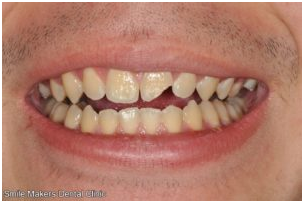Chipped or broken teeth
Restoring Chipped or Broken Teeth
Breaking a tooth can be distressing. Take consolation that with modern dentistry there is much that can be done to help you.
The management of a chipped tooth will depend much on the extent of the injury or damage to the tooth.
1. Cosmetic contouring
If the chip of the tooth is very minor, for example, just a little edge of a tooth, often nothing needs to be done.
If the chipped area bothers your tongue or it affects your appearance, some gentle re-contouring can be done. This will make it more comfortable for your tongue and make the chip less noticeable. This procedure only takes a few minutes.
2. Bonding

If the chip is more significant, but not extensive enough to injure the dental pulp (nerve), then the shape of the tooth can be restored with tooth-coloured resin that bonds to the tooth. This can often be done within an hour. Depending on the extent of the chip, if a significant amount of the tooth has to be built up.
Bonding is a relatively quick solution. Another advantage is that if the restoration chips or dislodges, it can be easily repaired.
3. Veneers
Veneers are a thin layer of porcelain or ceramic that is bonded to the front surface of the tooth to restore the shape and colour of the tooth. It does involve the removal of a thin layer of the tooth structure so that when the veneer is bonded on, the tooth does not look thick. Veneers usually take a few visits to be completed as the veneer is custom-made in a dental laboratory. Veneers can give very good results as it can present an even natural colour for the tooth. Care must be taken not to crack ice or other hard objects as the ceramic veneer can chip. Daily, careful brushing and flossing are essential to keep the margins of the veneered tooth clean so that the tooth does not succumb to decay.

4. Crowns
If the tooth is extensively broken then a crown may be needed. A crown can be made of a variety of materials e.g. metal alloys or gold for the back teeth and ceramic for the front teeth. A crown restores the shape of the tooth above the gum i.e. the natural crown of the tooth, hence the name.
Note that if the injury to the tooth extends to the pulp or nerve of the tooth, then root canal treatment will be needed before the crown can be constructed. Crowns can cost depending on the material and difficulty involved.
Crowns can last for 10 years or more, with good care. If the tooth has sustained a vertical fracture or a crack that extends into the root, restoring the tooth may not be possible.
If the tooth has to be removed there are ways of replacing the tooth.
You will be advised on all your options so that you can select the treatment best suited to your circumstances.
